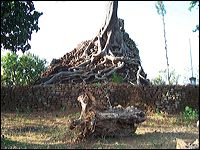|
Selasa, 16 September 2008 |
| Mpu Sindok
|
 Following the shift of political power from central to eastern Java at the beginning of the 10th century, the first kingdom to emerge was called Isana, established by Mpu Sindok in A.D. 929. The capital, at Watugaluh, is thought to have been located on the banks of the Brantas river, in the region of Jombang. Following the shift of political power from central to eastern Java at the beginning of the 10th century, the first kingdom to emerge was called Isana, established by Mpu Sindok in A.D. 929. The capital, at Watugaluh, is thought to have been located on the banks of the Brantas river, in the region of Jombang.
Sindok is reported to have had two wives, one of whom, Sri Parameswari Dyah Kbi, may have been the daughter of Dyah Wawa, the last known ruler of ancient Mataram in Central Java. Since it is known that Sindok had formerly held a high ministerial position in the Mataram government, it seems likely that he was recognized as the successor to Dyah Wawa on the strength of this marriage.
Despite the discovery of quite a number of stone inscriptions dating from Sindok's reign, the information which they reveal has not helped to shed very much light on this historical period. Our most informative source, in fact, dates from the following century, when East Java was ruled by King Airlangga. An inscription known as the 'Calcutta Stone', so named because it is preserved in the Indian Museum of Calcutta, traces the genealogy of Airlangga back to King Sindok. Thus we are informed that, following Sindok's death in A.D.947/8, the throne was taken over by his daughter, Sri Isana Tunggawijaya, who was married to a Sri Lokapala. Their son and successor, Sri Makutawangsawardhana, was known as the 'Sun of the Isana Dynasty'. It was from the union of his daughter, Mahendradatta, with the Balinese ruler Udayana, that Airlangga was born.
|
|
| 0 Comments: |
|
| |
 |
| |
|
|





